What kind of batteries does Tesla use?
Tesla’s recent announcement at their press conference stated that the company will fully transition to using lithium iron phosphate batteries (LFP) as the standard battery for their products globally. In addition, Tesla entered a product supply agreement with Ganfeng Lithium Co., Ltd. The agreement specifies that from January 1, 2022, to December 31, 2024, the company and Ganfeng International will supply Tesla with battery-grade lithium hydroxide.
It is worth considering the types of batteries Tesla uses, such as lithium iron phosphate and high-nickel, and in what scenarios they are used. For entry-level products and energy storage stations, lifelong cycle performance remains a priority, in which case lithium iron phosphate batteries are preferred. Thus, it is anticipated that the entry-level vehicle, which Tesla referred to as the $25,000 car, would be equipped with lithium iron phosphate batteries.
For mid-range products, Tesla prioritizes battery capacities that provide long-range batteries according to customer demand. Therefore, the current batteries for long-range products are cobalt-free batteries made around nickel and manganese compounds.
In the case of weight-sensitive products such as pickups and heavy trucks, Tesla prioritize battery performance where high-nickel batteries are required, and this is the important area where Tesla currently develops independently.
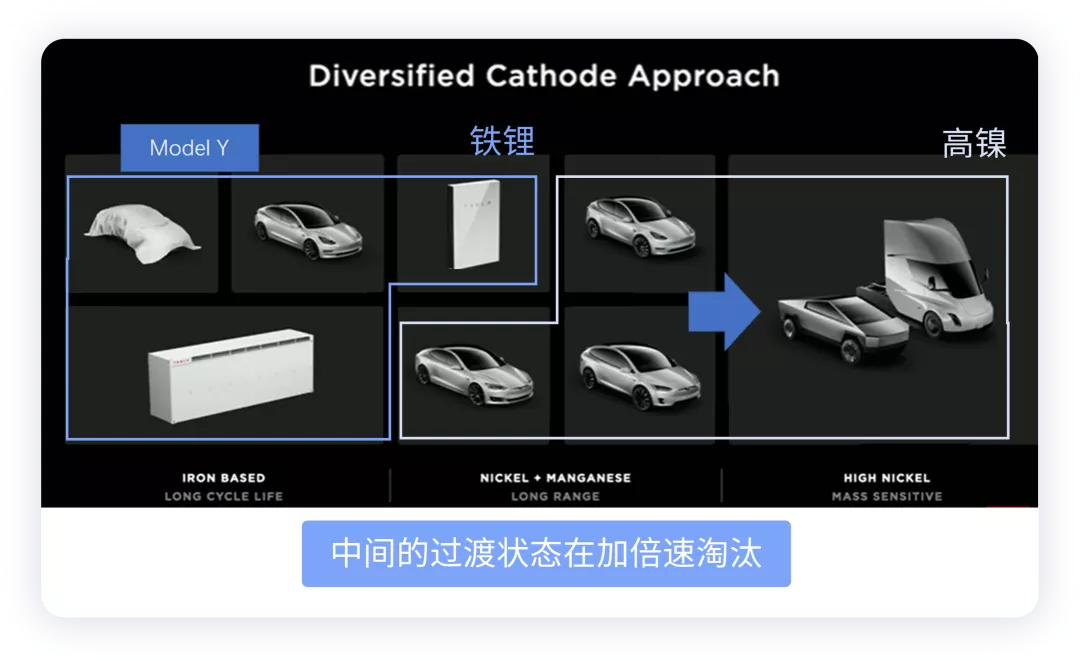
Tesla’s Master Plan
Tesla CEO Elon Musk set a new target for Tesla during an investor meeting in October to break through 20 million electric vehicle annual sales by 2030.
Tesla’s manufacturing capabilities are expected to be around 2 million units per year starting in 2022, with over 450,000 units produced in China, over 600,000 produced in California, and the Berlin factory expecting to start production in the upcoming weeks. Based on the production of 5,000 Model Y vehicles per week, short-term annual production can be raised to around 240,000 units, which could also be increased to the scale of Shanghai in the future. Texas will likely become Tesla’s headquarters in the future, with an anticipated production capacity of around 500,000 units.
Thus, Tesla’s overall production capacity is expected to be around 2 million units by 2022.
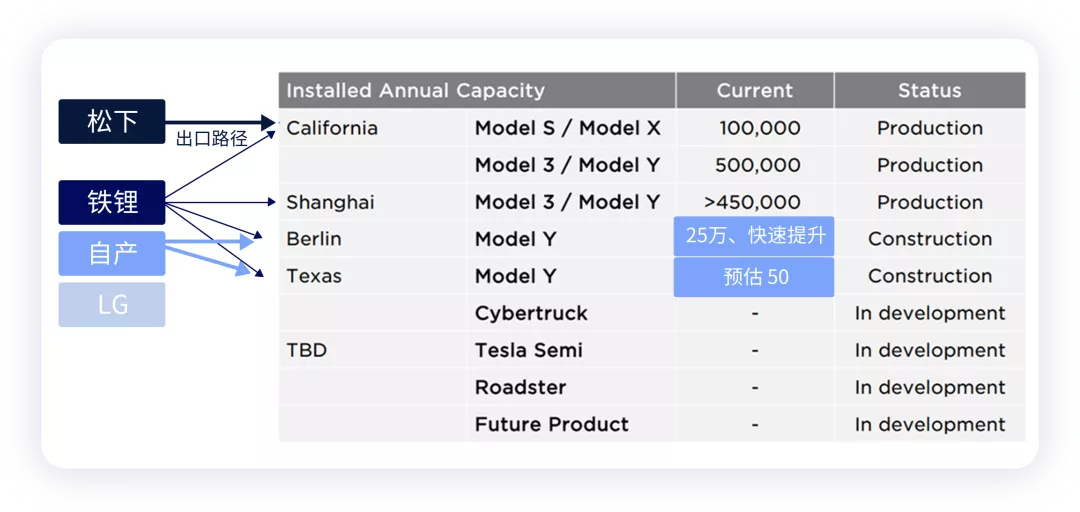 In Tesla’s technology roadmap, they started with Panasonic’s 18650 batteries, moved to 21700 batteries, imported LG Chem, and then introduced CATL’s lithium iron phosphate batteries. Tesla firmly grasped the initiative.
In Tesla’s technology roadmap, they started with Panasonic’s 18650 batteries, moved to 21700 batteries, imported LG Chem, and then introduced CATL’s lithium iron phosphate batteries. Tesla firmly grasped the initiative.
In terms of battery selection, Tesla is currently the world’s largest purchaser of power batteries, with a widening gap from the second place. In 2020, Tesla organized its own talent system to design and manufacture battery cells with 4680 big cylindrical specifications, which truly cut into the core of electric vehicles, and it is quite admirable. This plan was demonstrated at the opening ceremony of the Berlin factory, where we saw not only the 4680 batteries but also the CTC design around the 4680 batteries.
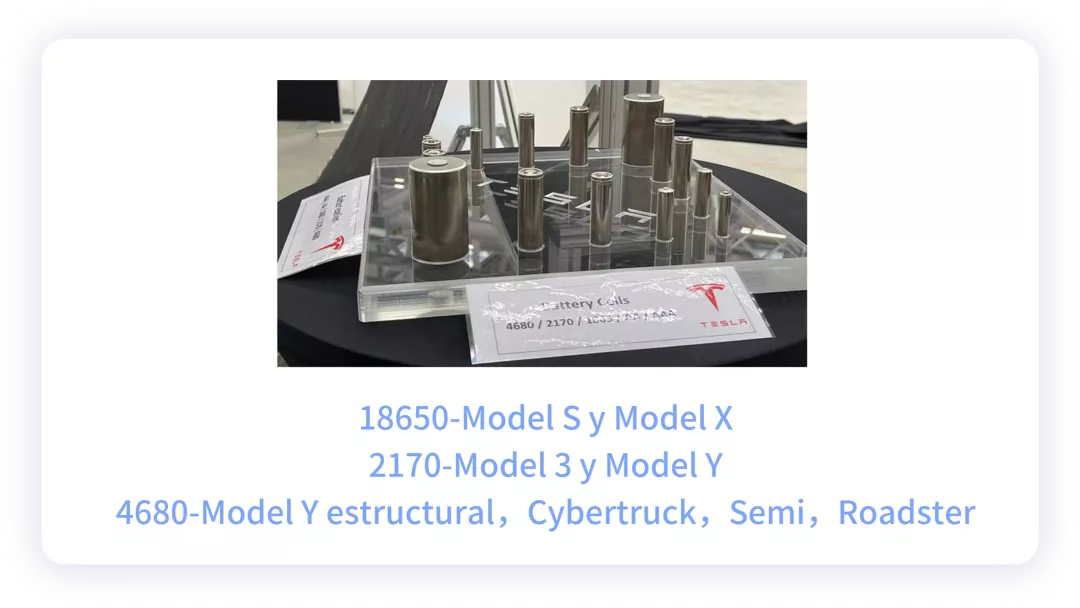
To be honest, the cell samples, battery system design sections, and Tesla’s detailed design seen at the Berlin factory are very shocking. In the specific design, Tesla continues to use the side cooling of the battery cells, 4680 arranged horizontally in the body, considering the deep integration of the battery and the electric vehicle itself, truly thinking and optimizing the battery fully embedded in the body.
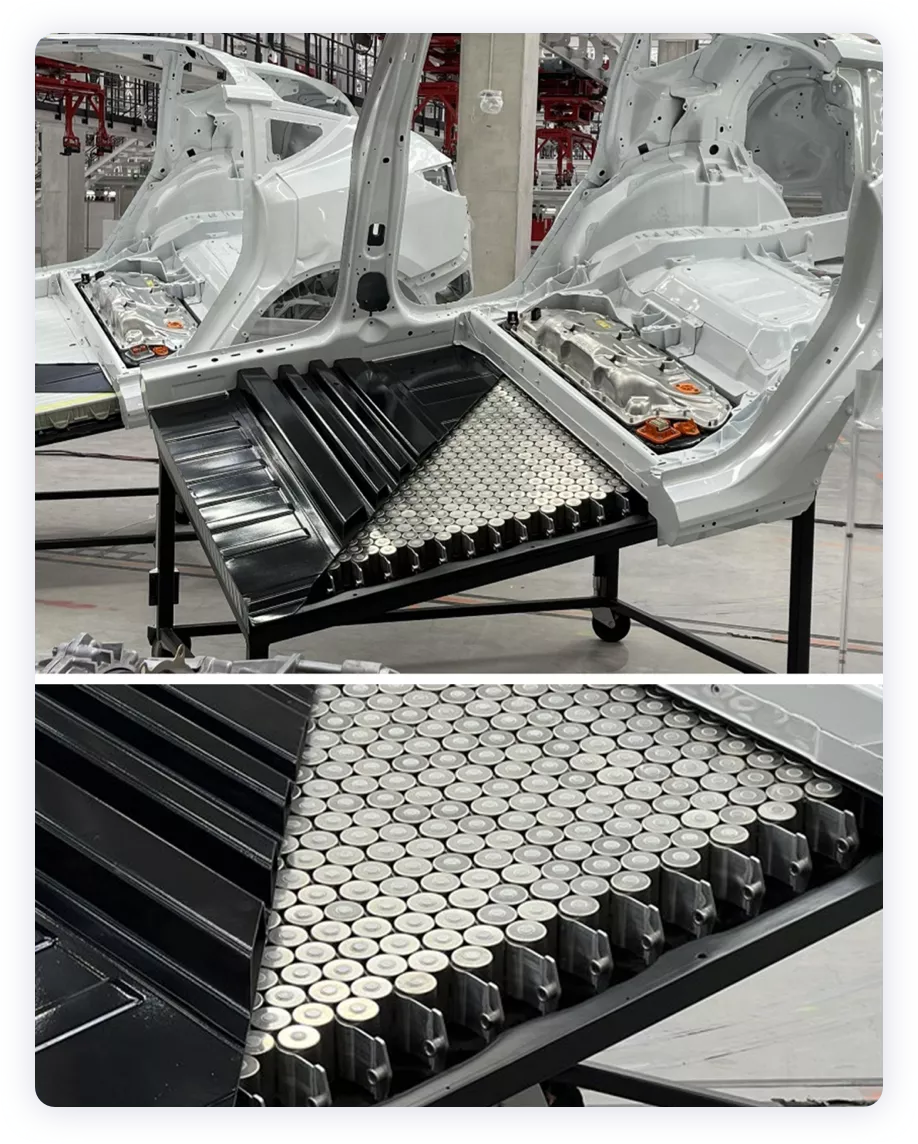
High-nickel batteries are the core element for Tesla to consider reducing dependence on cobalt and reducing battery costs.
Since this year, due to the rapid increase in demand for lithium iron phosphate, lithium carbonate prices have risen rapidly.
As shown in the figure below, to some extent, Tesla has converted the newly added demand from the previous amounts of NCA+ and NMC811 to lithium iron phosphate, reduced the demand for cobalt, stabilized the cobalt price, and also reduced some nickel resources demand.
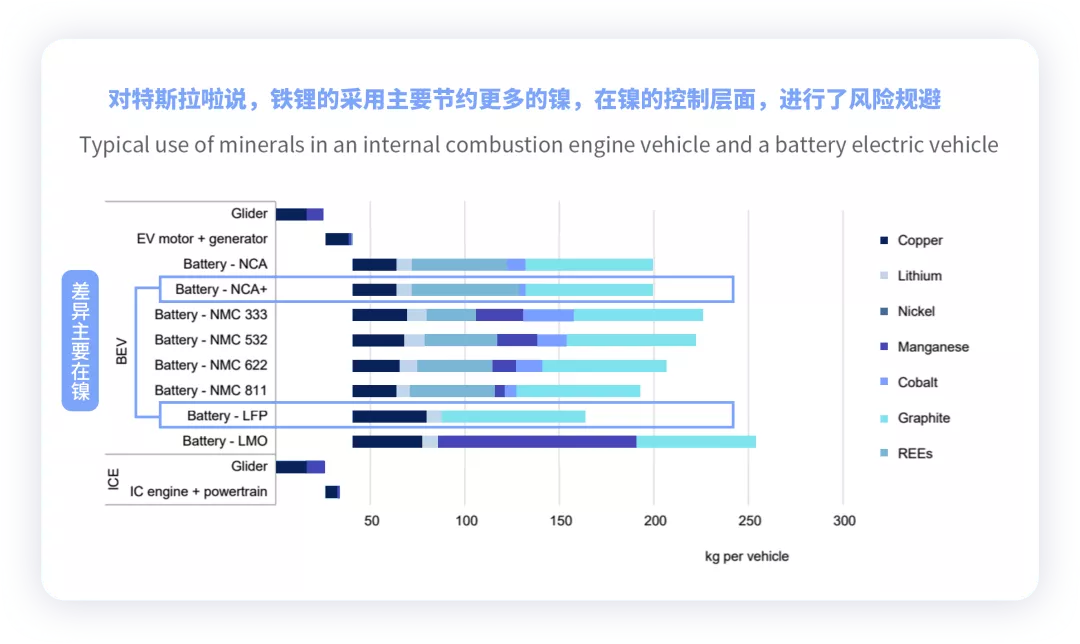
In fact, according to Tesla’s previous layout, through the development of high-nickel positive electrode material, they aimed to achieve a 15% price reduction in materials, which is of strategic importance.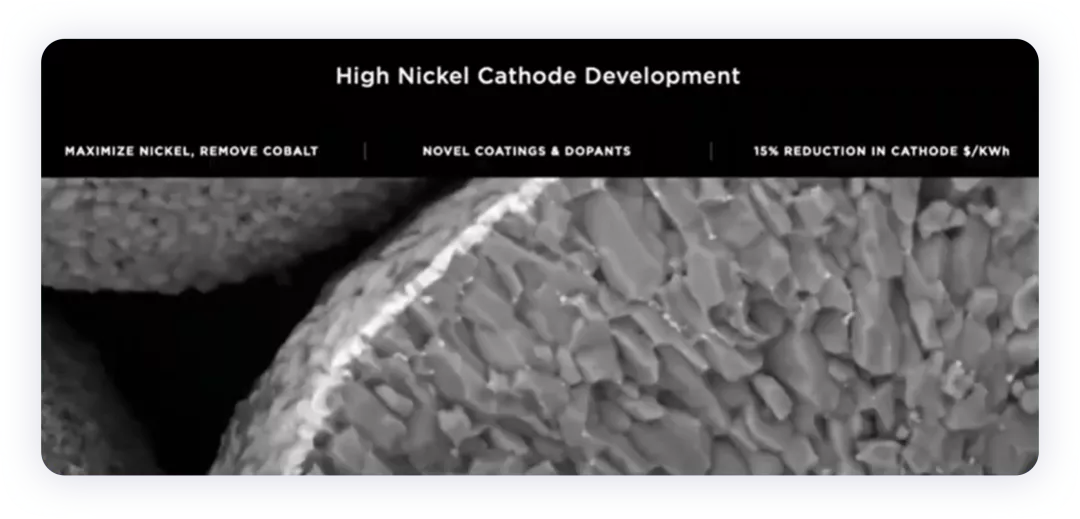
According to Tesla’s roadmap, current lithium iron phosphate batteries mainly rely on Chinese suppliers, while the development of high-nickel batteries relies on both Tesla’s own team and suppliers such as Panasonic and LG Chem. In terms of high-nickel batteries, Tesla is confident in increasing the range by 54% (with contributions from cell design, negative electrode, positive electrode and cell chassis integration of 16%, 20%, 4%, and 14%, respectively); decreasing unit cost by 56% (with contributions from cell design, cell factory, negative electrode, positive electrode and cell chassis integration of 14%, 18%, 5%, 12%, and 7%, respectively). This means that the expected cost of the battery can be reduced from 100 US dollars/kWh in 2021 to 56 US dollars/kWh in 2025; and decreasing unit investment by 69%. This represents Tesla’s ability to significantly increase its production line capacity and increase battery production (with contributions from five measures of 7%, 34%, 4%, 16%, and 8%, respectively).
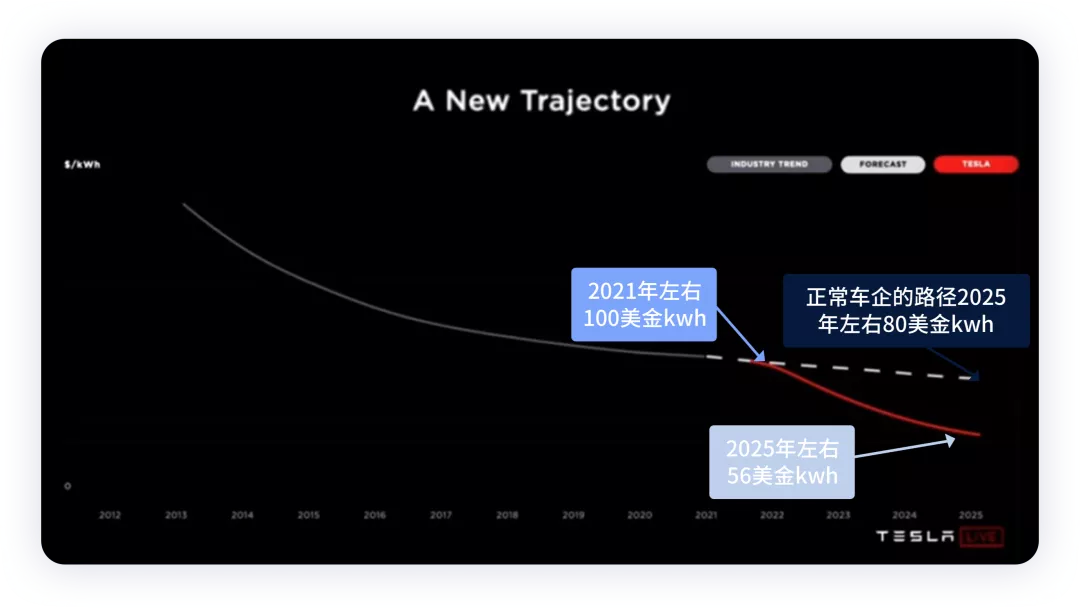
The most important thing in 2021 is the implementation of the 4680 large cylindrical battery from the PPT to reality. From 18650 to 21700 to 46800, Tesla’s preferred path is still cylindrical cells. The battery released this time has a diameter of 46mm, a height of 80mm, a capacity that can be increased 5 times, and an increased range of 16%, while reducing cost by 14%.
The biggest challenge here is fast charging speed. Due to the larger size, the heat generated inside the cell is difficult to dissipate during super-fast charging, so the innovation of the leadless ear design reduces the distance of the current, achieving a decrease in internal resistance.
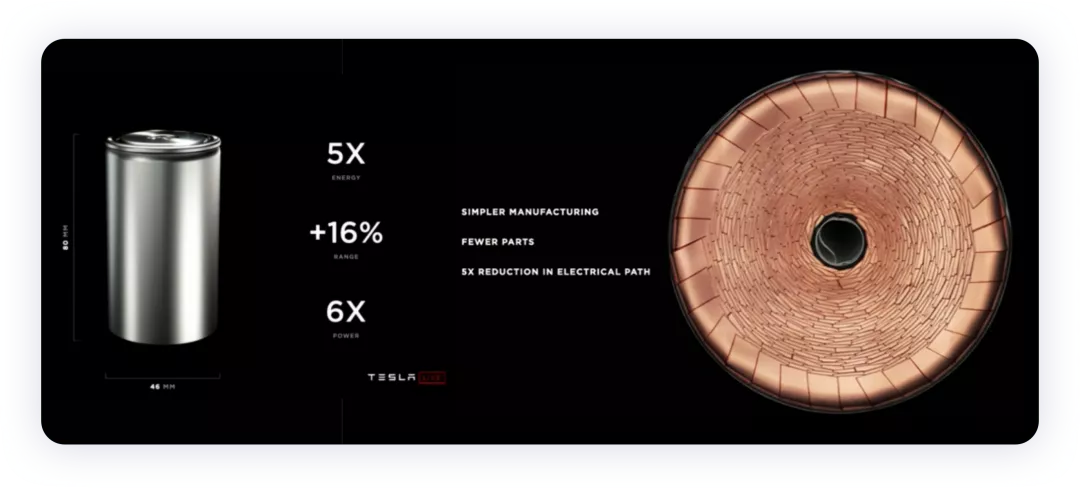
Safety issues of high-nickel batteries
As mentioned yesterday, Soteria’s safety solution mainly includes the use of 811/graphite 5Ah soft pack stacked batteries in the sample, which can still be used after puncture, maintaining 93% capacity retention. After the adoption of similar designs in Tesla, the safety of high-nickel batteries is completely guaranteed.
1) The Dreamweaver separator high-temperature diaphragm:“`
Dreamweaver may be a non-woven diaphragm that is very stable at a temperature of 300℃ without obvious shrinkage according to Soteria. After the addition of aramid fiber reinforcement, the temperature can be further stabilized at 550°C.
2) Polymer-based metal-coated collector:
Soteria’s collector is the core technology of its safety design, and Polymer uses different materials in comparison.
To achieve the safe design of high nickel batteries, it is necessary to comprehensively consider the combined effects of the diaphragm and composite collector. The high-temperature-resistant diaphragm will not cause short circuits due to thermal shrinkage over a large area, and the polymer-based collector will fuse after being heated, functioning like a fuse in a battery cell.

Conclusion: In the long run, high nickel batteries provide higher energy density for human use, and the demand for resources is concentrated in the bulk requirement for nickel, which is relatively easy to solve. Therefore, it is essential to closely monitor the development of technology!“`
This article is a translation by ChatGPT of a Chinese report from 42HOW. If you have any questions about it, please email bd@42how.com.